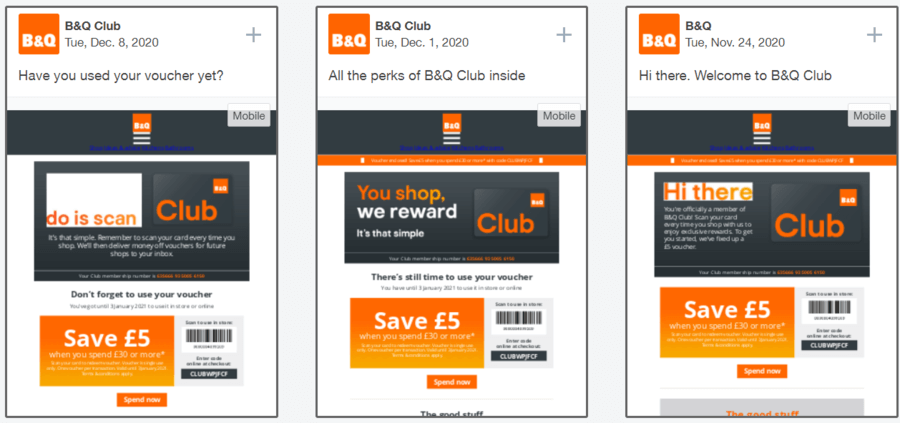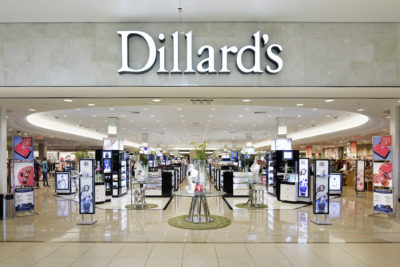Your email list is only as good as the engagement it delivers.
Getting people to sign up for your email program is one thing, but creating an email drip campaign that makes them open, read, and click every email you send is a whole different ball game.
In this post, we’ll go over the types of email drip campaigns you can use to keep subscribers engaged, and provide drip campaign examples from leading brands for you to use as inspiration.
What is an email drip campaign?
A drip campaign—sometimes called a marketing drip campaign—is an automated series of pre-written emails that go out at specific times and/or based on certain subscriber actions.
Drip campaigns are an integral part of running an effective ecommerce email marketing strategy.
When someone signs up to your email program and is (automatically) put into a drip campaign, they might receive a welcome email from you immediately, another email two days after the first, yet another email two days after the second, and so on.
Ideally, the content of your email drip campaigns is related to the content of the page or post the subscriber signed up from.
For example, a health food brand might have a sign-up box at the bottom of a recipe for a vegetarian quiche. Once someone signs up and enters the drip campaign linked to that sign-up box, they may get an email asking them to click one link if they’re a vegetarian and another if they’re not. By doing so, they’ll be put into a second sequence that branches off the first and either delivers vegetarian-only content, or a series of emails about all kinds of healthy foods.
When you’re brainstorming email drip campaign ideas, make a list of your different customer profiles and the types of products you offer. Both can act as the starting point for a drip campaign.
Benefits of using email drip campaigns
As mentioned above, one of the main benefits of setting up email drip campaigns is that they are pre-written and automated, meaning they are relatively simple to manage once you handle the initial setup.
Other benefits of drip campaigns are that they:
- Address important needs throughout the customer journey, delivering an ideal customer experience
- Allow you to easily segment your list by letting subscribers indicate their interests
- Lower unsubscribes as you can more easily tailor content to different segments of subscribers
- Keep your list engaged throughout the year
Last, but definitely not least important, drip campaigns tend to have an 80 percent higher open rate than general email broadcasts, as well as a three times higher click-through rate.
Including drip marketing campaigns into your email marketing allows you to increase the performance of your list without having to continuously come up with new ideas or manually send out new emails. Each of your drip emails is an automated email—while you will want to run tests, it is possible to set and forget about a drip campaign for a while once it’s running smoothly.
Tools to bring your drip campaigns to life
Much like your other marketing emails, drip marketing campaigns require you to test and adapt advanced email marketing strategies to drive the most success from your efforts.
You will need to use an email marketing solution or email service provider (ESP) that supports automated drip campaigns so your team can easily identify relevant audiences from your CRM, design a sequence of emails based on the subscriber’s activity, and measure if you’ve achieved your goals.
Without the right email marketing solution, it is incredibly complex—and likely impossible—to create a meaningful drip campaign.
Email drip campaign examples
MailCharts tracks drip campaigns from thousands of brands, including many the emails their campaigns consist of, what times these emails are sent, and how many days fall in between sends.
We’ve gathered some of the best drip campaign examples below to inspire your strategy.
Welcome campaigns
Welcome emails have a 58.7 percent open rate vs. the average 14.6 percent open rate for normal emails. If a welcome email is sent right after someone signs up, that open rate jumps to 88.3 percent!
In other words, not creating a welcome drip campaign means leaving a lot of engagement on the table.

In the automated drip campaign example above, B&Q sends an account confirmation email followed by a welcome email that promotes its club membership. The brand knows the user is keen to engage when they’ve just signed up, and seizes that moment to have them take action once more.
To make it extra easy for the new subscriber, B&Q offers them the option to join its club by clicking the “join now” button through their app, or by registering the card the customer may have gotten during a shop visit.
Onboarding and activation campaigns
Oftentimes, brands combine welcome emails with an onboarding email campaign through which they try to get new email subscribers to take their first action. This action can be making a purchase, but it can also be a lower barrier action like downloading an app.

We saw how B&Q uses its welcome campaign to promote its membership program. Once a subscriber signs up for that program, B&Q puts them in this onboarding campaign which first shares a discount code so that new subscribers can start shopping straight away.
The voucher is only valid for a limited time only, and so, B&Q’s second email in this campaign reminds the subscriber to use it. The brand also highlights membership benefits again.
The subject line of their last email in this drip campaign jumps right in by asking whether the user has used their voucher yet. The focus of this email isn’t entirely on the sale, as B&Q also tries to segment this user by asking them if they’re a homeowner or not, and whether they have a garden or not.
This drip campaign is a good example of a sequence that has a main purpose (getting the user to make their first purchase) while also offering additional information and engagement options.
If you need more onboarding ideas, head over to the MailCharts database for more examples of effective onboarding drips.
Cart abandonment campaigns
According to Shopify, 67.45 percent of online shopping carts are abandoned before the visits completes the purchase. That’s a lot. But abandoned doesn’t need to mean lost forever—just filter prospective customers into your cart abandonment drip campaign.

In this drip campaign example, Kérastase sends cart abandoners three emails. Two are sent two days in a row, while the third is sent a few days later. Each time, the abandoned product is put front and center.
The first email in this sequence gives the customer a gentle nudge by mentioning the items they put in their cart have been saved. It also mentions Kérastase’s Afterpay service, which allows customers to buy in installments if their budget is tight right now.
The second email contains a “gentle reminder” for the customer to complete their order, while the third email throws in some discount power by offering 20 percent off (but only if the customer buys more than $100).
That third email is also the end of Kérastase’s attempt to make that sale.
We have hundreds of other cart abandonment email examples in our database so you can see how other brands encourage shoppers to come back to their sites.
Win-back campaigns
When someone isn’t engaging with your emails anymore, they’ve probably lost interest in your brand, right?
Wrong.
An impressive 45 percent of inactive customers that are put through a win-back campaign will engage with later emails again. That’s not a number to ignore. But how do you re-engage subscribers?
Some brands send discounts, others send personal product recommendations, but we love this simple one-email win-back drip campaign from ThirdLove:
We miss you.
It does one thing perfectly: remind the customer how easy and hassle-free it was to try their new bras at home. Would they like to do that again? With free shipping for purchases over $50, it’s a no-brainer, really.
In the end, good marketing plays to emotion and that’s exactly what ThirdLove does here.
We encourage you to review more win-back campaign examples to see how your brand can win back its customers.
Order, shipping, and delivery confirmation sequences
The order-to-delivery drip campaign is one that relies both on user and brand actions. It’s set in motion with an order confirmation email as soon as the customer makes a purchase, and the following emails depend on the brand’s shipping and delivery process.

In the above drip campaign example, Kate Spade sends customers a purchase receipt shortly after they’ve placed an order. This is followed by not just a shipping confirmation email, but also a heads up email to let the customer know their order will arrive the next day.
This creates a positive sense of anticipation and also serves a practical goal: it allows the customer to plan to be at home to receive the package, if needed.
The brand sends out another email once the package has been delivered. This may seem a bit redundant, but courier services may leave a package with a neighbor or at a pick-up point if the customer isn’t there to accept it. In that case, this email lets the customer know they should check their mailbox for a delivery slip.
A few days after the delivery, Kate Spade sends a final email to ask customers how they like their purchase. The brand even embeds a very short review form directly into the email to make it very easy for the customer to leave a review.
Birthday drip campaigns
Birthday drip campaigns are great for lead nurturing. While you do need to know your subscribers’ birth date to send these, that added personalization instantly makes this type of email campaign more powerful.
Happy birthday cecelia! Ready to unwrap your gift?
In this drip campaign example, fashion brand Joie sends its subscribers two birthday emails five days apart. The first email, pictured above, is clear and simple. It wishes the recipient a happy birthday and offers them $50 off purchases of $200 or more.
The subtle call to action button is followed by a product image that acts a bit like a teaser, as the jumpsuit displayed is only partially shown.
Have you gone birthday shopping yet, cecelia?
The second email serves as a reminder for the recipient to treat themselves. The discount is offered again, and this time the jumpsuit of the first email is shown in full.
This subtle imagery and messaging work well for Joie, which positions itself as a luxury brand.
Lastly, note how the subject lines of both birthday emails (“Happy birthday Cecelia! Ready to unwrap your gift?” and “Have you gone birthday shopping yet, Cecelia?”) address the recipient directly by name, making it more likely they’ll click to see what’s inside.
Get more ideas with these 11 birthday email examples that showcase how other brands approach this valuable drip campaign message.
Loyalty drip campaigns
Get started with Starbucks® Rewards
Starbucks sends four drip campaign emails to customers who sign up for their loyalty program—see their first email above. This automated email tells members how to get started with the loyalty program (by downloading the app) and reminds them of the benefits they’ll gain.
The Starbucks app is ready to take your order
The second email is sent three days later and invites loyalty members to start using the app they have presumably downloaded. It also re-explains some of the benefits of using the app, such as saving your favorites for easy ordering and earning rewards you can exchange for free drinks and food, in case the subscriber hasn’t downloaded it yet.
Order now and collect Stars
The messaging of the third email, sent two days after the second, is almost identical. But this time, the headline focuses on the app feature that allows you to save and order your favorite Starbucks treats.
So many ways to collect Bonus Stars
The last email is sent a little over a week later and introduces the user to “Bonus Stars,” which are special in-app offers only available to app users.
Over the course of this email marketing campaign, new Starbucks members learn to download and use the app to fully enjoy the benefits their membership provides.
Re-engagement drip campaign
Some of your subscribers will inevitably stop engaging with your emails, which is an opportunity to start a re-engagement drip campaign.
Come back and save 20%!

Sometimes, all a customer needs to revisit your store or site is a discount. In the above example from Edible Arrangements, disengaged subscribers are invited to get 20 percent off their next order of $69+. The brand even highlights some of its newest munchies—talk about a delicious deal.
You can try different methods to re-engage your subscribers in addition to a discount, such as explaining how your product or service improves their life, showcasing new products or updates they’ve missed, and reminding subscribers why they signed up for your emails in the first place.
Cross-sell and upsell campaigns
The best marketers use customer data to understand which other products or services their audience may be interested in—and a drip email campaign is perfect for cross-selling and upselling your customers.
You’re gonna <3 your new item

The above post-purchase upsell email from Tarte Cosmetics is a great example of how your brand can recommend items based on a recent purchase. You can send similar messages to your customers automatically a few days after they make a purchase, or after their order is delivered.
Like to save money? This is for you.

If your brand offers a tiered subscription service, you can also use upsell drip emails to remind customers about the benefits of upgrading their plan. The above email from Book of the Month is incredibly simple, and explains how customers can save using a yearly plan. You can schedule these to send every couple of months or before your customer’s subscription is up for renewal.
Other email drip campaign ideas
The above are just a few examples of email drip campaigns, but you don’t need to stop there. Any sequence of emails that makes sense to your brand and keeps your list engaged can be turned into a drip campaign.
Some more drip campaign examples include:
- Challenges based on shop browsing behavior
- Holiday and other season-specific email drip campaigns
- Educational drip campaigns that help your customer get the most value from your service
Improve your list’s performance with email drip campaigns
By dripping email content tailored to your subscribers’ interests and customer profiles, you can keep them engaged throughout the year and lower your number of unsubscribes. Use the drip campaign examples in this article for inspiration to create or revamp your own campaigns.
Want to know how your competitors are using email drip campaigns? Sign up for a free MailCharts account and get instant access to their campaigns and workflows, alongside thousands of other examples.











